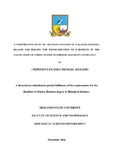Please use this identifier to cite or link to this item:
https://cris.library.msu.ac.zw//handle/11408/3004Full metadata record
| DC Field | Value | Language |
|---|---|---|
| dc.contributor.author | Chipendo, Tawanda Michael | - |
| dc.date.accessioned | 2018-04-27T13:30:29Z | - |
| dc.date.available | 2018-04-27T13:30:29Z | - |
| dc.date.issued | 2016 | - |
| dc.identifier.uri | http://hdl.handle.net/11408/3004 | - |
| dc.description.abstract | A study was carried out on substrate pasteurisation for P. ostreatus cultivation. The major aim of this work was to compare the effectiveness of wood ash, hydrated lime, bleach and boiling for pasteurisation of the substrate for cultivation of white oyster mushroom, Pleurotus ostreatus, on maize straw. To achieve this objective, weed occurrence, the number of days to completely colonise the straw (NDCC), the number of days to initiate primordial sprouting (NDIPS), the number of primordial colonies (NPC), the yield of the first fruiting flush (YFF) and the duration of the first fruiting flush (DFF) were measured. Analysis of Variance for RBD was done to compare NDCC and YFF. NDIPS, NPC and DFF were compared using the nonparametric Friedman’s test. There was low infestation of straw with Trichordema as well as yellow mould (Aspergillus spp.) in three bags. The NDCC was significantly different across treatments (ANOVA, p= 0.000) and boiling recorded the fastest rate of mycelial colonisation of straw taking 16.67 days. There was no significant treatment effect on DTIPS (χ2(3) = 4.188, p= 0.242) with the mean NDIPS ranging from 4.00, on boiled straw, to 4.67, on both bleach and wood ash. NPC also showed no significant treatment effect (χ2(3) = 1.575, p= 0.665) with treatment means ranging from 1.33, on bleach-treated straw, to 1.83 on boiled straw. YFF showed significant differences (ANOVA, p= 0.000) for at least two treatments. The lowest yield was obtained on straw pasteurised with bleach (BE = 22.30%) while ash-pasteurised straw gave the highest yield (BE= 37.34%). DFF showed no significant treatment effect (χ2(3) = 4.860, p= 0.182). The mean DFF ranged from 16.67, on bleach-treated straw, to 18.00, on boiled straw. Pasteurisation of the mushroom substrate using sifted wood ash proved best for achieving high yield. Pasteurising using wood ash however requires more time for spawn run. Mushroom farming trainers can be encouraged to incorporate some of the chemical pasteurisation methods like use of bleach, hydrated lime and wood ash into their training programs especially in in urban areas where wood is not readily available. Instead of disposing of wood ash, farmers may consider using it for the purposes of growing mushroom and reduce the amount of fuel demand for the enterprise. | en_US |
| dc.language.iso | en | en_US |
| dc.publisher | Midlands State University | en_US |
| dc.subject | Substrate pasteurisation | en_US |
| dc.title | A comparative study of the effectiveness of alkaline soaking, bleach and boiling for pasteurization of substrate in the cultivation of white oyster mushroom (pleurotus ostreatus) | en_US |
| item.fulltext | With Fulltext | - |
| item.languageiso639-1 | en | - |
| item.grantfulltext | open | - |
| Appears in Collections: | Bsc Biological Sciences Honours Degree | |
Files in This Item:
| File | Description | Size | Format | |
|---|---|---|---|---|
| tawanda DISSERTATION .pdf | Full Text | 958.48 kB | Adobe PDF |  View/Open |
Page view(s)
266
checked on Oct 23, 2025
Download(s)
404
checked on Oct 23, 2025
Google ScholarTM
Check
Items in MSUIR are protected by copyright, with all rights reserved, unless otherwise indicated.



